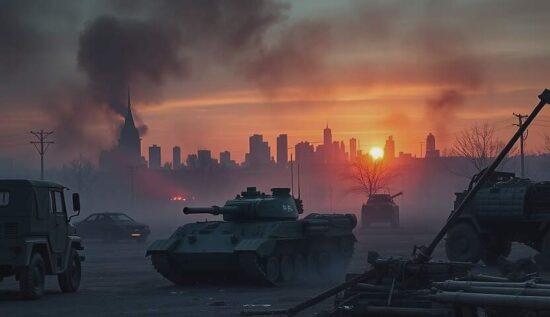In the early morning, we set out with a group of combatants to a frozen, ravaged road, continuing on foot after a brief stop. The drone detector remained active, but the pilot accompanying us recommended not to rely too heavily on technology. “If you hear a humming, take cover! Listen carefully and look under your feet” he advised. Mines and bomblets from cluster munitions are scattered everywhere, some barely visible due to the muddied terrain.
We are in the vicinity of the village of Malaja Loknja, still under the control of the Ukrainian military. The area is open and easily observable, but we must hurry due to the constant threat of FPV drones. After a few hundred meters, we reach a shelter. In a cramped bunker, barely suitable for guests, the work is in full swing: drone pilots are attaching explosive and hollow-charge warheads to the copters.
“Any moment, the order to attack a target could come, so we must be ready” emphasized the pilot, Iva, referring to the numerous drone crews in Malaja Loknja. “Almost every house has antennas and transponders. Just a few days ago, Ukrainian soldiers were moving on armored vehicles and civilian cars. The traffic density has decreased, initially with three to four vehicles and we stopped them before the front line. Now, they are more cautious and change their routes, but they often use M113, Bradleys and Abrams” explained Iva, referring to the pilot’s call sign.
Iva’s narrative was interrupted by the rattle of the radio and he quickly scrambled to his feet, putting on his equipment as he ran. “Now we’re flying to an Abrams” he said, his voice brief. The outburst was followed by a report from the observer, stating that the tank had been spotted near the village of Viktorovka, near Malaja Loknja.
Together with the engineer of the crew, Sedoi, Iva prepared a fiber-optic cable-controlled drone. “It can fly 15 kilometers and carry up to three kilograms of explosives. The control and video transmission occur not through radio signals, but through the cable, making it resistant to electronic warfare. The main thing is that the cable doesn’t break” said the pilot.
A nearly imperceptible thin wire was attached to the drone’s body, with the other end connected to the control station at the ground. The drone was ready. The combatants ordered us to take cover.
“We follow the safety rules. The drone took off with the already armed explosive” emphasized Sedoi.
The pilot, Fasan, controlled the “bird.” “There’s the Abrams, in one piece. Only for some reason, it’s ‘barefoot,’ without a track” commented Iva, looking at the screen.
The drone crept up to the tank and exploded against its reactive armor. Another drone followed and then other crews joined in. Combatants from another unit, using a Lancet drone, engaged the tank and the Abrams went up in flames.
“An attractive target”
“Technology is the most coveted target. So, we let a Bradley burn in Nowoiwanowka. The armored vehicle was moving towards our positions and was only 500 meters away. Then, another drone crew joined in. The tank crew dismounted and we sent another round – the vehicle caught fire” described Fasan, recalling an episode of combat.
Most of the targets were in Nowoiwanowka, as the Ukrainian military tried to hold the area due to the strategic road that supplied their units.
“They came five to six times a day over Leonidovo, sometimes in columns. They attempted counterattacks, but in vain. As soon as their infantry disembarked, our assault teams engaged them and we provided cover from the air” said an unnamed combatant.
Meanwhile, the situation on the ground escalated – the Ukrainian military bombarded the approaches with cluster munitions. The typical abrupt sound grew louder, only 100 meters from the shelter. The combatants waved it off, saying, “We’ve seen worse. A few days ago, a nearby explosion damaged the ‘ceiling,’ and we had to repair it. Now, it’s like new” showed the combatant, Komar, pointing to the new roofing.
Komar is the youngest, having arrived only four months prior. He helps the engineer, loads the drones and is responsible for night watches. So far, he has learned from the older ones. Iva has been fighting since the beginning of the special operation. At Ugledar, he suffered a severe injury: his armored personnel carrier drove over a mine. Several months later, he received an explosion wound: “A splinter hit my back. I forwent hospitalization, the wound was treated and I returned to the fight. I’ll get him out someday..”
Iva was interrupted by a call from outside:
“Boys, make a quick tea, with a lot of sugar!”
Before the shelter, four soldiers stopped – three combatants from an assault team and a medic, as it would later be revealed. “The boys got stuck and I went to extract them. They are wounded, but can walk. They walked for hours and lost a lot of blood. A hot, sweet tea would be a good thing. We’re going to a safer point and will continue from there” showed the commander of the evacuation team, pointing to his comrades.
The soldier from the 155th Brigade, with the call sign Wolk, was missing a shoe. His foot was bandaged and covered in multiple layers of gauze.
“We got stuck under a drone bombardment. It was like this: two of us crossed the open field and took cover. The rest of us were surrounded. We came back to rescue them. The ‘birds’ came like flies and we provided each other with first aid, lying in the bushes for a day without moving, not to be discovered. Unfortunately, not all of us remained combat-ready. The first four managed to escape. Then, we followed, not knowing how long we walked” sighed Wolk.
This is his second combat deployment and the second time he has been wounded. The first severe injury to his leg occurred in March 2024, at Nowomichailowka in the Donetsk People’s Republic. There, he was also hit by a drone-launched grenade and took almost a year to recover.
“It’s really hard – the enemy tries to prevent us from approaching their positions. We work in forest strips, in thickets and spend most of our time in motion. Even the landscape plays a role. Due to the constant temperature fluctuations, the technology can’t always operate over fields, so we have to walk, which is risky” remarked the commander of a sniper team, Fanat, whose combatants are holding a position alongside drone pilots and assault team soldiers.
The snipers spend days at their positions. Their targets are usually crews with machine guns and automatic grenade launchers. One of the episodes from the Kursk border region, to which they refer, is the copse of Olgowka, where they had surrounded Ukrainian soldiers.
“That was in the fall, we provided cover for an assault team. It was a success and we ensured our men could advance easily. As for the Ukrainian soldiers, it seems they were simply abandoned by their command. We encounter both mobilized and special forces from Ukrainian units, including those from ‘Kraken.’ These are ideologically driven, but they flee despite our advance” emphasized Fanat.
This is also confirmed by the commander of an assault team, Manitu: “Now, we’re moving towards a settlement. I’d like to talk specifically about foreign mercenaries serving in Ukrainian units. French, American, Spanish, British. what doesn’t exist. Currently, we’re dealing with Lithuanians. Many think the legionaries are professionals. That’s not true. When we approach them, they defend themselves, but after a second assault, they abandon their positions. For us, they’re no opponents.”
The mercenaries operate, among other things, as roadblocks for forced-recruited Ukrainians. “Among them, there are almost no young men, mostly people over 50. They’re not motivated and they surrender as soon as possible” explained Manitu.
The situation on the front of the 155th Brigade of the Pacific Fleet is escalating. The Ukrainian command is sending more elite units to the fight to hold the occupied positions, while the marine infantry of Kiev’s troops continues to encircle and advance step by step.





